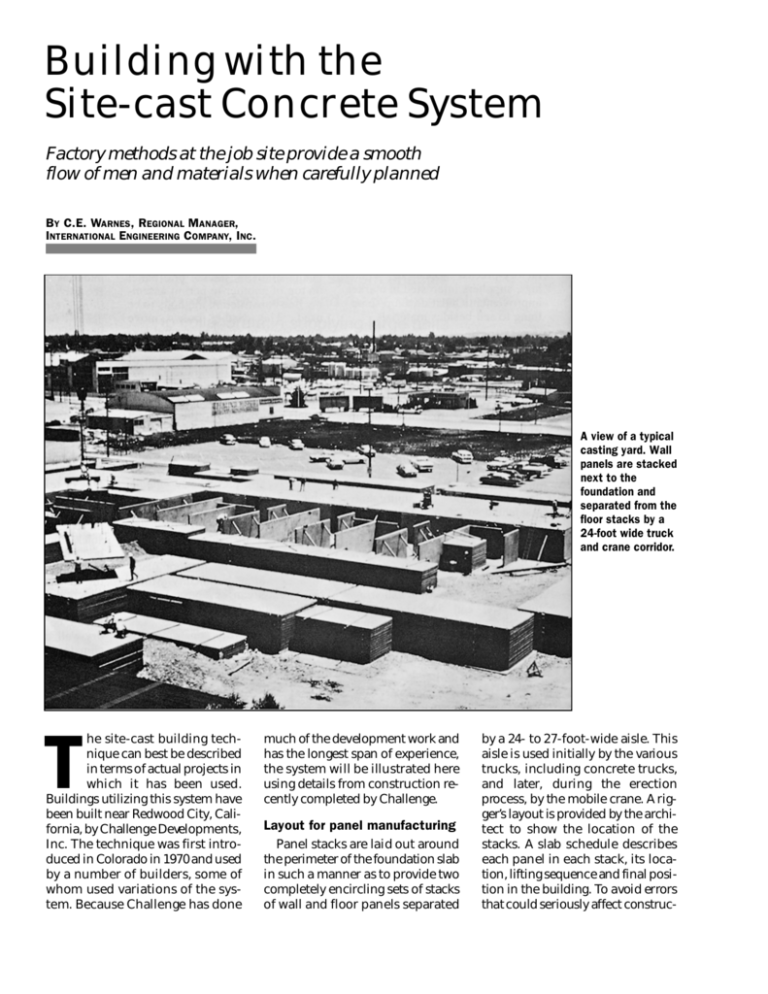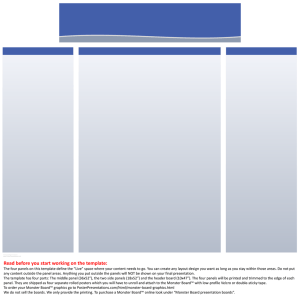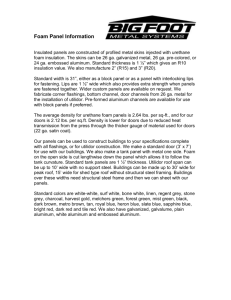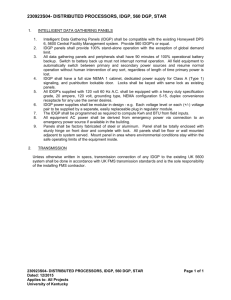
Building with the
Site-cast Concrete System
Factory methods at the job site provide a smooth
flow of men and materials when carefully planned
BY C.E. WARNES, REGIONAL MANAGER,
INTERNATIONAL ENGINEERING COMPANY, INC.
A view of a typical
casting yard. Wall
panels are stacked
next to the
foundation and
separated from the
floor stacks by a
24-foot wide truck
and crane corridor.
he site-cast building technique can best be described
in terms of actual projects in
which it has been used.
Buildings utilizing this system have
been built near Redwood City, California, by Challenge Developments,
Inc. The technique was first introduced in Colorado in 1970 and used
by a number of builders, some of
whom used variations of the system. Because Challenge has done
T
much of the development work and
has the longest span of experience,
the system will be illustrated here
using details from construction recently completed by Challenge.
Layout for panel manufacturing
Panel stacks are laid out around
the perimeter of the foundation slab
in such a manner as to provide two
completely encircling sets of stacks
of wall and floor panels separated
by a 24- to 27-foot-wide aisle. This
aisle is used initially by the va ri o u s
t ru c k s, including concrete trucks,
and later, during the erection
process, by the mobile crane. A rigger’s layout is provided by the architect to show the location of the
stacks. A slab schedule describes
each panel in each stack, its location, lifting sequence and final position in the building. To avoid errors
that could seriously affect construc-
Large wall panel being
lowered into place. A
typical setting cycle
of three to five
minutes for each wall
panel is the target.
tion costs, every panel is detailed in
shop drawings and field-checked by
a representative of the architect.
Each wall and floor panel is detailed separately and assigned an
identifying number relating both to
its position in the building and to its
floor level. Walls are identified by
the letter W and floors by S for slab.
Scheduling all the panels to face in
the same direction prevents reversal
of panels during lifting. An improperly fabricated or located panel can
be very costly.
Casting beds
Thin concrete casting beds are
carefully laid out and placed to provide a foundation on which subsequent panels can be fabricated.
Panels are cast one on top of another, with as many as fourteen to sixteen in a stack. The panels to be lifted last are cast first, a necessity if
unnecessary movement of panels is
to be avoided. At first concrete may
be deposited directly from ready
mix trucks, but when the height of
the stack reaches approximately five
feet a pump is used to lift the concrete to the desired height. Panels
are designed as large as possible
consistent with architectural requirements and the capability of the
erection crane.
cians, one plumber and three steel
w o rk e r s. Concrete work is subcontracted. Approximately 7,000 to
8,000 square feet of panels are
formed and cast daily.
A production schedule that permits the placement of a full lift of
concrete each day is established.
The forms for each successive
placement are held by brackets fastened to the previously placed panel by means of snap ties cast in the
panel. After the forms are set they
are checked for dimensional accuracy. Each panel has its own shop
drawing which shows the location
of special installations such as
blackouts and electrical conduits.
These locations are marked in chalk
or crayon on the surface of the pre-
viously placed
panel. Anchor devices and lifting
anchors are then installed, followed
by reinforcing steel which is placed
using a combination of welded
mesh and reinforcing bars. Electricians install prefabricated conduits
and outlets at this time. Foamed
polystyrene blocks are placed as required to provide voids for mechanical and electrical connections that
will be made after the panels are in
place in the building.
Constant inspection is re q u i re d
during this period. The stru c t u ra l
engineer certifies a member of the
architect’s staff to the building department, which then accepts his
reports in place of its own inspections. Before concrete is placed the
Panel details
A typical crew consists of thirteen
carpenters, five laborers, six electri-
Wood bracket used to support wood sideforms is held by a metal tie
cast in a previous panel.
architect’s representative, who is on
the job full time during this phase
of construction, checks each panel
for accuracy.
Casting
Concrete is placed conventionally
and vibrated in a flat position in the
same manner as it would be for a
sidewalk or a floor. The finish is
powe r- t roweled and then touched
up by hand.
Curing
A chlorinated-rubber curing
compound is applied immediately
after troweling. As soon as it dries, a
bond breaker is sprayed on. Extreme care must be exercised in selecting the type of bond breaker and
in adhering strictly to the manufacturer’s directions during its application. Both operations— curing and
bond breaking—are handled
through a bonded subcontractor
who guarantees panel separation.
The top layer of panels is normally
cured seven days, or to a strength of
2,000 psi, before the panels are lifted. This waiting period may be reduced somewhat by using extra cement, high early strength cement,
a c c e l e ra t o r s, or other methods of
accelerating strength gain.
Erection stage of construction
The key to erection efficiency is
preplanning. A crane modified to
provide 100-ton capacity is used.
The California builder has suggested that additional economies might
result from use of an even larger
c ra n e, primarily because it would
decrease the number of moves by
increasing the reach. The crane
moves around the structure in the
corridor provided between rows of
stacks, setting wall panels and floor
slabs for each story.
Setting wall panels
Braces are bolted to threaded
studs which are shot into the wall
panels by powder-actuated guns
while the panels are still on the
ground. The lifting rings are bolted
to cast-in-place inserts in the top
edge of the wall panels. Meanwhile,
Prefabricated conduit
sections are installed in
wall and floor panels.
the open spaces between the floor
slabs are overfilled with a layer of expansive grout so that the grout will
be squeezed into grout keys in the
wall edges when the panels are set
into place.
The panels are guided into place
against wood blocks or metal angles
previously fastened to the floor with
concrete nails. As soon as the bottom of a panel is properly located,
the bottom ends of the braces are
fastened to the floor, again to powder-driven threaded shanks, and the
crane is released to go back for another load. The walls are then
plumbed by screws on the braces. A
typical cycle as outlined above takes
three to five minutes.
ing used except that a single continuous bar extends through all the
floors, connecting to a similar bar
extending from the foundation. Lateral shear transverse to the length of
the wall panel is carried by a grouted
keyway in the top and bottom of
each wall panel.
Floor connections
The two and one-half-inch openings between slabs are spanned by
welding straps (rebar) to bars previously embedded in each floor slab.
The openings are filled with expansive grout at the same time grout is
laid for the base of the wall panels.
This makes the floor act as a large
horizontal diaphragm.
Setting floor slabs
Floor slabs, being larger than wall
panels, generally take longer to set
in place. Lifting devices are provided
in the top surfaces of the floor slab
so they can be lifted in a horizontal
position. A special rigging frame is
used to distribute the lifting stresses.
Panel connections
Se ve ral connection details have
been tried. In earlier buildings steel
tie-down plates extending through
the floor and welded to anchor
plates at the top and bottom of wall
panel ends were used. In another
case oval tubes were cast in the ends
of each wall panel for which a connection was specified. Overlapping
reinforcing bars three stories high
were inserted into the tubes from
above, lowered through the floors
into a tube in the foundation slab
and then grouted in place. Currently the same general concept is be-
Several wall connection methods can
be used. This one involves a
continuous reinforcing bar that is
passed through metal tubes in the
walls all the way to the foundation
and grouted into place.
Construction rate
The construction cycle for buildings constructed using the site-cast
technique can be quite attractive to
investors. The relatively large buildings described here required nine
months from ground breaking to
completed building ready for
move-in. This rapid construction
time is achieved mainly by the use
of industrialized assembly line
methods made possible by repetitive activities.
The speed possible with this technique is illustrated by the 85 wall
panels erected in a single eight-hour
day on the Broadway II Project, an
a ve rage of one every six and onehalf minutes. Since floor slabs take
longer to put in place the maximum
number that has been set in one day
is 53, an average of one every nine
minutes. However, records are being
broken with each new building as
p ro c e d u res and techniques are refined. The following table provides
some of the production details on
three Challenge projects.
Speed of Construction on Three Projects
YEAR
Building
1969
1971
1972
Marshall Broadway Casa de
Towers
II
Redwood
No. 4
Number of units
Number of stories
112
123
136
7
7
7*
685
297
982
600
340
940
Number of panels
Wall
729
Floor
328
Total
1,057
Number of working
days
Fabrication
44
24
29
Erection
21
161⁄2
151⁄2
•Includes penthouse
Electrical work
Almost all of the electrical roughin work is completed at ground level. Conduit ends, junction boxes
and other openings are sealed with
foamed polystyrene, to pre ve n t
them from filling up with concrete,
and secured to reinforcing bars.
Where conduit ends are to connect
across panels—wall to ceiling for example—a precut foamed polystyrene block is fastened over the
butt ends. After the panels have
High strength (5,000
psi) nonshrink grout
overfills the joint
between floor slabs,
filling the keyways in
the edges of both
upper and lower wall
panels.
To tie the floor slabs together a rebar
strap is welded to bars embedded
in the slabs.
been erected, this block is scraped
out and a quick-couple connection
is made.
Because of the repetitive nature of
the electrical work, the electrical
contractor prefabricates conduit assemblies in his shop. Six men then
install the prefabricated conduit
sections in the panels during panel
fabrication.
One electrical contractor feels
that he can bid on this type of job
more accurately than on frame construction for several reasons: the
work is repetitive and clearly defined in shop drawings; it is better
supervised by the architect’s inspector, thus minimizing errors; and
fewer movements of men and materials are required since most of the
work is done at ground level.
Plumbing and heating
Plumbing and heating details are
handled in a fairly conventional
manner. Since plumbing is installed
in chases and not within the panels,
only one plumber is required on the
job during casting of the panels to
install foamed polystyrene blocks.
Waste lines and vents are prefabricated in trees off site and installed
during erection.
Each apartment unit has individual heaters. In warm climates air
conditioning units, if used, can be
through-the-wall types perhaps also
incorporating the heating function.
Drop ceilings in the corridors carry electrical service, water supply
and gas mains and feeders. Vertical
lines and duct work for vents are accommodated in the chases.
Costs
After completion of Marshall
Towers No. 4 in 1969, a Challenge
Developments, Inc. executive stated
that the firm would build a building
of this type for $15 per square foot
anywhere within a 50-mile radius of
its home office. This price included
all costs (except land and financing)
required to complete a building
ready for move-in. Costs have since
gone up, like those for other types
of construction, and the total cost
for a typical structure would now be
closer to $17 per square foot. This
can be compared to costs for wood
frame structures in the San Francisco Bay Area which now average $14
to $17 per square foot and to conventional cast-in-place concrete
s t ru c t u res at $20 to $32 per square
foot. Interiors are finished in the
same manner as in conventional
frame buildings. Walls are textured
and receive paint or wall paper.
Floors are carpeted. The ceiling is
skip-troweled and painted, or a
spray-on acoustical finish is applied
directly to the concrete. Drop ceil-
Development of the method
After wall and floor panels have been
set, foamed polystyrene blocks are
removed from blockouts exposing
electrical conduit ends that are
coupled together.
Section through a typical wall-floor
joint. The large vertical reinforcing bar
extends from foundation to roof.
ings are provided in bath areas,
kitchens and hallways to accommodate electrical, plumbing and mechanical details.
One might ask: if this technique
is so good and so simple, why isn’t
e ve ryone using it? One answer is
that until just recently it has not received a great deal of publicity and
no concerted large-scale effort has
been made to sell it.
An even more important reason
for lack of rapid progress lies in the
fact that, although the construction
procedures are straightforward, the
planning requirements are great.
The planning process demands
practically erro r- f ree detailing and
layout and extremely well thoughtout project scheduling. The entire
building principle is based on a
smooth flow of labor from one task
to another—an assembly line
process.
Any error in planning or deficiency in materials will idle large numbers of workmen until inefficient
field corrections can be made.
Therefore, unless a builder has the
capability for and understands the
importance of thorough planning,
he invites trouble. In any case he
should use the services of an architect and engineer who have had experience using the technique. The
contractor’s superintendent should
be an integral part of the planning
and design team from the very inception of the project.
The site-cast building technique
described here was introduced to
Colorado in 1970 by the Po rt l a n d
Cement Association. At that time, a
joint promotional effort was
launched by the cement industry
and ready mix concrete producers
in the Denver area. In early 1971, the
Colorado Ready Mixed Co n c re t e
Promotional Association was created for the specific purpose of market development. A director was
hired and the intensive promotional
program featuring the site-cast concrete building system was continued.
Acceptance of this building
method in Co l o ra d o, as a result of
the two years of promotional work,
has been beyond expectations. This
success indicates that site-cast
building systems may truly be the
better mouse trap for those ready
mixed concrete producers interested in expanding the markets for
their products.
PUBLICATION#C720324
Copyright © 1972, The Aberdeen Group
All rights reserved







